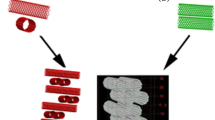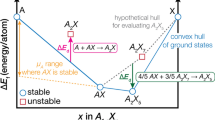Abstract
It has been observed in both natural and man-made materials that volume sometimes decreases with increasing temperature. Though mechanistic understanding has been gained for some individual materials, a general answer to the question “Why does volume sometimes decrease with the increase of temperature?” remains lacking. Based on the thermodynamic relation that the derivative of volume with respect to temperature, i.e., thermal expansion, is equal to the negative derivative of entropy with respect to pressure, we developed a general theory in terms of multiscale entropy to understand and predict the change of volume as a function of temperature, which is termed as zentropy theory in the present work. It is shown that a phase at high temperatures is a statistical representation of the ground-state stable and multiple nonground-state metastable configurations. It is demonstrated that when the volumes of the nonground-state configurations with high probabilities are smaller than that of the ground-state configuration, the volume of the phase may decrease with the increase of temperature in certain ranges of temperature-pressure combinations, depicting the negative divergency of thermal expansion at the critical point. As examples, positive and negative divergencies of thermal expansion are predicted at the critical points of Ce and Fe3Pt, respectively, along with the temperature and pressure ranges for abnormally positive and negative thermal expansions. The authors believe that the zentropy theory is applicable to predict anomalies of other physical properties of phases because the change of entropy drives the responses of a system to external stimuli.






Similar content being viewed by others
References
C. Kittel, Introduction to Solid State Physics. John Wiley & Sons, New York, 2005.
A.W. Sleight, Isotropic Negative Thermal Expansion, Annu. Rev. Mater. Sci., 1998, 28, p 29–43.
J.S.O. Evans, Negative Thermal Expansion Materials, J. Chem. Soc. Dalt. Trans., 1999, 19, p 3317–3326.
G.D. Barrera, J.A.O. Bruno, T.H.K. Barron, and N.L. Allan, Negative Thermal Expansion, J. Phys. Condens. Matter, 2005, 17, p R217–R252.
W. Miller, C.W. Smith, D.S. MacKenzie, and K.E. Evans, Negative Thermal Expansion: A Review, J. Mater. Sci., 2009, 44, p 5441–5451.
C. Lind, Two Decades of Negative Thermal Expansion Research: Where Do We Stand?, Materials, 2012, 5(1125), p 1154.
R. Mittal, M.K. Gupta, and S.L. Chaplot, Phonons and Anomalous Thermal Expansion Behaviour in Crystalline Solids, Prog. Mater. Sci., 2018, 92, p 360–445.
K. Takenaka, Progress of Research in Negative Thermal Expansion Materials: Paradigm Shift in the Control of Thermal Expansion, Front. Chem., 2018, 6, p 267.
E. Liang et al., Negative Thermal Expansion: Mechanisms and Materials, Front. Phys., 2021, 16, p 53302.
T.H.K. Barron, and G.K. White, Heat Capacity and Thermal Expansion at Low Temperatures. Kluwer Academic/Plenum, Boston, 1999.
B. Fultz, Vibrational thermodynamics of materials, Prog. Mater. Sci., 2010, 55, p 247–352.
L. Zhu, M. Garst, A. Rosch, and Q. Si, Universally Diverging Grüneisen Parameter and the Magnetocaloric Effect Close to Quantum Critical Points, Phys. Rev. Lett., 2003, 91, p 066404.
P. Hohenberg, and W. Kohn, Inhomogeneous Electron Gas, Phys. Rev. B, 1964, 136, p B864–B871.
W. Kohn, and L.J. Sham, Self-Consistent Equations Including Exchange and Correlation Effects, Phys. Rev., 1965, 140, p A1133–A1138.
N. Mardirossian, and M. Head-Gordon, Thirty Years of Density Functional Theory in Computational Chemistry: An Overview and Extensive Assessment of 200 Density Functionals, Mol. Phys., 2017, 115, p 2315–2372.
M.G. Medvedev, I.S. Bushmarinov, J. Sun, J.P. Perdew, and K.A. Lyssenko, Density Functional Theory is Straying from the Path Toward the Exact Functional, Science, 2017, 355, p 49–52.
Vienna Ab-initio Simulation Package (VASP). https://www.vasp.at.
Y. Wang, Z.K. Liu, and L.-Q. Chen, Thermodynamic Properties of Al, Ni, NiAl, and Ni3Al From First-Principles Calculations, Acta Mater., 2004, 52, p 2665–2671.
Y. Wang, M.Q. Liao, B.J. Bocklund, P. Gao, S.L. Shang, H.J. Kim, A.M. Beese, L.Q. Chen, and Z.K. Liu, DFTTK: Density Functional Theory Toolkit for High-Throughput Lattice Dynamics Calculations, CALPHAD, 2021, 75, p 102355.
Z.K. Liu, Y. Wang, and S. Shang, Thermal Expansion Anomaly Regulated by Entropy, Sci. Rep., 2014, 4, p 7043.
M. Hillert, Phase Equilibria, Phase Diagrams and Phase Transformations: Their Thermodynamic Basis. Cambridge University Press, Cambridge, 2008.
Z.K. Liu, and Y. Wang, Computational Thermodynamics of Materials. Cambridge University Press, Cambridge, 2016.
Z.K. Liu, Computational Thermodynamics and its Applications, Acta Mater., 2020, 200, p 745–792.
Z.K. Liu, S.L. Shang, and Y. Wang, Fundamentals of Thermal Expansion and Thermal Contraction, Materials (Basel), 2017, 10, p 410.
Z.K. Liu, B. Li, and H. Lin, Multiscale Entropy and Its Implications to Critical Phenomena, Emergent Behaviors, and Information, J. Phase Equil. Diffus., 2019, 40, p 508–521.
Z.K. Liu, L.Q. Chen, K.E. Spear, and C. Pollard, C. An Integrated Education Program on Computational Thermodynamics, Kinetics, and Materials Design. https://www.tms.org/pubs/journals/JOM/0312/LiuII/LiuII-0312.htmlhttps://www.tms.org/pubs/journals/JOM/0312/LiuII/LiuII-0312.html (2003).
Y. Wang et al., Thermodynamics of the Ce Gamma-Alpha Transition: Density-Functional Study, Phys. Rev. B, 2008, 78, p 104113.
Y. Wang et al., A Thermodynamic Framework for a System with Itinerant-Electron Magnetism, J. Phys. Condens. Matter, 2009, 21, p 326003.
Y. Wang, S.L. Shang, H. Zhang, L.-Q. Chen, and Z.K. Liu, Thermodynamic Fluctuations in Magnetic States: Fe3Pt as a Prototype, Philos. Mag. Lett., 2010, 90, p 851–859.
Liu, Z. K. Entropy. YouTube Video https://youtu.be/QZydut4y0hw (2021).
DFTTK: Density Functional Theory Tool Kits. https://www.dfttk.org/.
Z.K. Liu, Y. Wang, and S.-L. Shang, Origin of Negative Thermal Expansion Phenomenon in Solids, Scr. Mater., 2011, 65, p 664–667.
Funding
The work presented in this paper came from many projects supported by funding agencies in the United States in last two decades with the latest ones including the National Science Foundation (NSF, with the latest Grants CMMI-1825538 and CMMI-2050069), Department of Energy (with the latest Grants being DE-FE0031553, DE-NE0008945, DE-EE0008456, DE-SC0020147, and DE-AR0001435), NASA Space Technology Research Fellowship (with the latest Grant 80NSSC18K1168), Army Research Lab (with the latest Grant W911NF-14-2-0084), Office of Naval Research (with the latest Grant N00014-21-1-2608), Wright Patterson AirForce Base, NASA Jet Propulsion Laboratory, and the National Institute of Standards and Technology, plus a number of national laboratories and companies that supported the NSF Center for Computational Materials Design (NSF, 0433033, 0541674/8, 1034965/8), the Roar supercomputer at the Pennsylvania State University, the resources of NERSC supported by the Office of Science of the U.S. Department of Energy under contract No. DE-AC02-05CH11231, and the resources of XSEDE supported by NSF with Grant ACI-1053575. The authors would like to thank numerous collaborators over the years as reflected in the publications listed in ref. 23. ZKL would like to thank Josiah Roberts from University of Buffalo for suggesting the term zentropy during a seminar. The preparation of manuscript is partially supported by the Endowed Dorothy Pate Enright Professorship at The Pennsylvania State University. The proper copyrights for all the figures are granted by respective publishers.
Author information
Authors and Affiliations
Corresponding author
Additional information
Publisher's Note
Springer Nature remains neutral with regard to jurisdictional claims in published maps and institutional affiliations.
This invited article is part of a special tribute issue of the Journal of Phase Equilibria and Diffusion dedicated to the memory of former JPED Editor-in-Chief John Morral. The special issue was organized by Prof. Yongho Sohn, University of Central Florida; Prof. Ji-Cheng Zhao, University of Maryland; Dr. Carelyn Campbell, National Institute of Standards and Technology; and Dr. Ursula Kattner, National Institute of Standards and Technology.
Rights and permissions
About this article
Cite this article
Liu, ZK., Wang, Y. & Shang, SL. Zentropy Theory for Positive and Negative Thermal Expansion. J. Phase Equilib. Diffus. 43, 598–605 (2022). https://doi.org/10.1007/s11669-022-00942-z
Received:
Revised:
Accepted:
Published:
Issue Date:
DOI: https://doi.org/10.1007/s11669-022-00942-z




